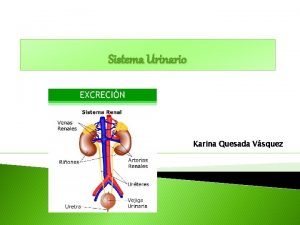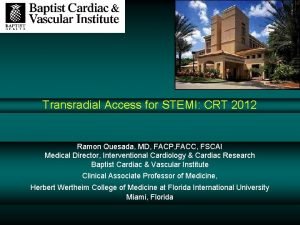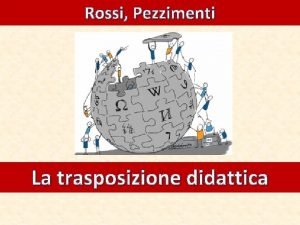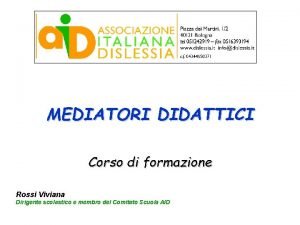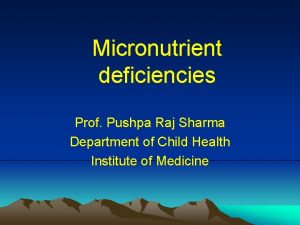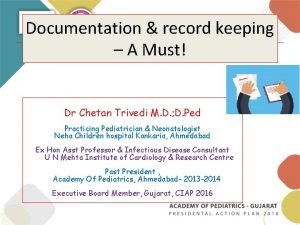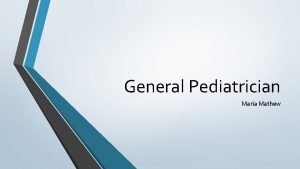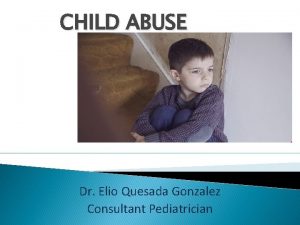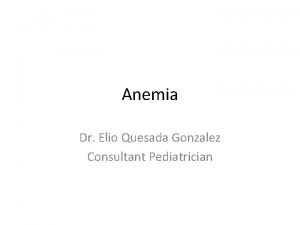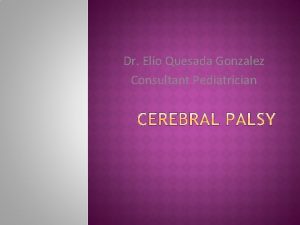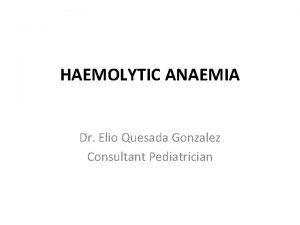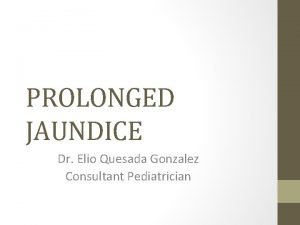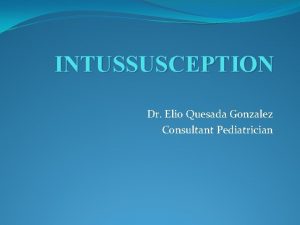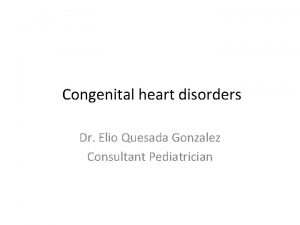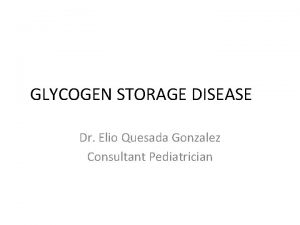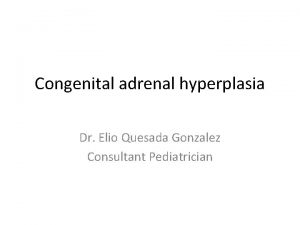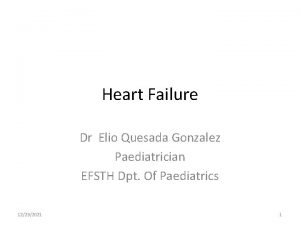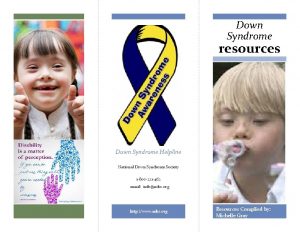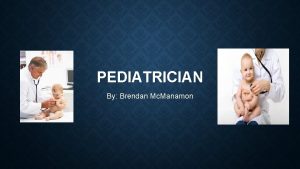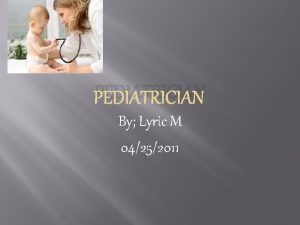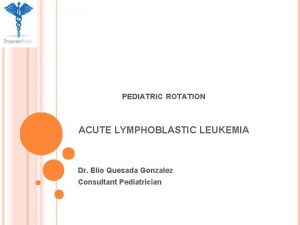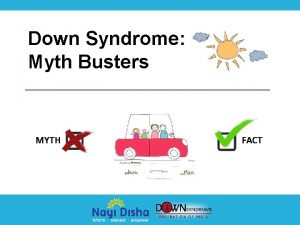DOWN SYNDROME Dr Elio Quesada Gonzalez Consultant Pediatrician




















- Slides: 20

DOWN SYNDROME Dr. Elio Quesada Gonzalez Consultant Pediatrician

What is Down Syndrome? • Down syndrome is a genetic disorder that causes a lifelong Intellectual Disability, developmental delays and other problems • Down syndrome varies in severity, so developmental problems range from moderate to serious • Down syndrome is the most common genetic cause of learning disabilities in children • Increased understanding of Down syndrome and early interventions make a big difference in the lives of both children and adults with Down syndrome

CAUSES • Human cells normally contain 23 pairs of chromosomes—one chromosome in each pair comes from the father, the other from the mother • Down syndrome results when one of three types of abnormal cell division involving chromosome 21 occurs • All three cell division abnormalities result in extra genetic material from chromosome 21, which is responsible for the characteristic features and developmental problems of Down syndrome • The three genetic variations that can cause Down syndrome include: trisomy 21, Mosaic down syndrome and translocation down syndrome

• TRISOMY 21 • MOSAIC DOWN SYNDROME • TRANSLOCATION DOWN SYNDROME

Karyotype of trisomy 21

Nature vs. Nurture • There are no known behavioral or environmental factors that cause Down syndrome

Is it inherited? • Most of the time, Down syndrome isn't inherited. It's caused by a mistake in cell division during the development of the egg, sperm or embryo • Translocation Down syndrome is the only form of the disorder that can be passed from parent to child. However, only about 4% of children with Down syndrome have translocation. And only about half of these children inherited it from one of their parents

Risk Factors • Some parents have a greater risk of having a baby with Down syndrome • Risk factors include: • Advancing maternal age. A woman's chances of giving birth to a child with Down syndrome increase with age because older eggs have a greater risk of improper chromosome division. However, most children with Down syndrome are actually born to women under age 35 because younger women have far more babies • Having had one child with Down syndrome.

Advancing maternal age

Common Symptoms • A distinct facial appearance: • Flattened facial features Flat Nasal Bridge Epicanthal folds hypotonia • Small head • Short neck • Protruding tongue • Upward slanting eyes, unusual for the child's ethnic group • Unusually shaped ears • Poor muscle tone • Broad, short hands with a single crease in the palm • Relatively short fingers • Excessive flexibility


Common symptoms continued… • Infants with Down syndrome may be of average size, but typically they grow slowly and remain shorter than other children of similar age • In general, developmental milestones, such as sitting and crawling, occur at about twice the age of children without impairment • Children with Down syndrome also have some degree of Intellectual Disability, most often in the mild to moderate range

Development milestones

COMPLICATIONS • Children with Down syndrome can have a variety of complications, some of which become more prominent as they get older, including: • Heart defects. Approximately half the children with Down syndrome are born with some type of heart defect. These heart problems can be life threatening and may require surgery in early infancy.

Complications continued. . • Leukemia. Young children with Down syndrome are more likely to develop leukemia than are other children. • Infectious diseases. Because of abnormalities in their immune systems, those with Down syndrome are much more susceptible to infectious diseases,

Complications continued. . • Dementia. Later in life, people with Down syndrome have a greatly increased risk of dementia. Signs and symptoms of dementia often appear before age 40 in people with Down syndrome. Those who have dementia have higher rate of seizures

Complications continued. . • Sleep apnea. Because of soft tissue and skeletal alterations that lead to the obstruction of their airways, children with Down syndrome are at greater risk of obstructive sleep apnea Life Expectancy • Life spans have increased dramatically for people with Down syndrome • In 1929, a baby born with Down syndrome often didn't live to age 10 • Today, someone with Down syndrome can expect to live to 50 and beyond, depending on the severity of his or health problems

Early Intervention • Early intervention for infants and children with Down syndrome can make a difference in realizing their potential abilities and in their quality of life • Early intervention programs vary from state to state, but they usually involve therapists and special educators whose goal is to help the baby develop motor skills, language, social skills and self-help skills

“We’re are more alike than different”

THANK YOU!!!! • Reference • Nelson textbook of pediatrics(19 edition) • Langman’s medical embryology(12 edition)
 Mercedes quesada etxaide
Mercedes quesada etxaide Vicente quesada ibarrola
Vicente quesada ibarrola Vuretra
Vuretra Ami quesada
Ami quesada Emmanuel quesada
Emmanuel quesada Trasposizione didattica cos'è
Trasposizione didattica cos'è Publio elio traiano adriano
Publio elio traiano adriano Elio vittorini san pietro clarenza
Elio vittorini san pietro clarenza Tabella dei mediatori didattici
Tabella dei mediatori didattici Suvullinen lisääntyminen
Suvullinen lisääntyminen Elio vittorini liceo
Elio vittorini liceo Istituto comprensivo elio vittorini san pietro clarenza
Istituto comprensivo elio vittorini san pietro clarenza Elio roca esposa e hijos
Elio roca esposa e hijos Elio carlos ricardo
Elio carlos ricardo Elio lo sapevi
Elio lo sapevi Damiano e i mediatori didattici
Damiano e i mediatori didattici Ensimmäiset monisoluiset eliöt
Ensimmäiset monisoluiset eliöt Dr pushpa raj sharma pediatrician
Dr pushpa raj sharma pediatrician Dr chetan trivedi
Dr chetan trivedi Pediatrician job description
Pediatrician job description Dr pushpa raj sharma pediatrician
Dr pushpa raj sharma pediatrician


